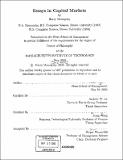| dc.contributor.advisor | Andrew W. Lo and Jiang Wang. | en_US |
| dc.contributor.author | Mamaysky, Harry | en_US |
| dc.contributor.other | Sloan School of Management. | en_US |
| dc.date.accessioned | 2005-08-22T23:20:06Z | |
| dc.date.available | 2005-08-22T23:20:06Z | |
| dc.date.copyright | 2000 | en_US |
| dc.date.issued | 2000 | en_US |
| dc.identifier.uri | http://hdl.handle.net/1721.1/9180 | |
| dc.description | Thesis (Ph.D.)--Massachusetts Institute of Technology, Sloan School of Management, 2000. | en_US |
| dc.description | Includes bibliographical references. | en_US |
| dc.description.abstract | The first two chapters of this dissertation study financial asset markets which are not "frictionless." The first chapter focuses on the effects of transaction costs. The second chapter focuses on the interaction between asymmetric information and strategic behavior. The third chapter empirically assesses the informativeness of certain types of price indicators based on technical analysis. In Chapter 1 ( co-authored with Andrew Lo and Jiang Wang) we propose a dynamic equilibrium model of asset pricing and trading volume with heterogeneous investors facing fixed transactions costs. We show that even small fixed costs can give rise to large "notrade" regions for each investor's optimal trading policy and a significant illiquidity discount in asset prices. We perform a calibration exercise to illustrate the empirical relevance of our model for aggregate data. Our model also has implications for the dynamics of order flow, bid/ask spreads, market depth, the allocation of trading costs between buyer and seller, and other aspects of market microstructure, including a square-root power law between trading volume and fixed costs which we confirm using historical US stock market data from 1993 to 1997. Chapter 2 develops an equilibrium model of a dynamic asymmetric information economy. The model is solved under two circumstances: where the informed and uninformed sectors are both competitive, and where the informed sector is competitive and the uninformed sector consists of a single, strategic agent. The strategic uninformed agent, when facing the same signals as the uninformed competitive sector, manages to extract different information abo~t the state of the economy. I find that expected returns, return variability, and unexpected trading volume differ between the competitive and the strategic economies. Furthermore, this difference depends on the degree of informational asymmetry between the two sectors. In the strategic economy, less surplus is lost due to informational arbitrage by the informed sector. Interestingly, the presence of asymmetric information allows even the competitive uninformed agents to gain surplus from allocational trade. Finally, I examine the incentives of agents to become better informed, and find that sometimes both competitive and strategic agents are better off under worse information. Technical analysis, also known as "charting," has been a part of financial practice for many decades, but this discipline has not received the same level of academic scrutiny and acceptance as more traditional approaches such as fundamental analysis. One of the main obstacles is the highly subjective nature of technical analysis-the presence of geometric shapes in historical price charts is often in the eyes of the, beholder. In Chapter 3 ( co-authored with Andrew Lo and Jiang Wang), we propose a systematic and automatic approach to technical pattern recognition using nonparametric kernel regression, and apply this method to a large number of U.S. stocks from 1962 to 1996 to evaluate the effectiveness of technical analysis. By comparing the unconditional empirical distribution of daily stock returns to the conditional distribution-conditioned on specific technical indicators such as head-and shoulders or double-bottoms-we find that over the 31-year sample period, several technical indicators do provide incremental information and may have some practical value. | en_US |
| dc.description.statementofresponsibility | by Harry Mamaysky. | en_US |
| dc.format.extent | 200 p. | en_US |
| dc.format.extent | 20309826 bytes | |
| dc.format.extent | 20309580 bytes | |
| dc.format.mimetype | application/pdf | |
| dc.format.mimetype | application/pdf | |
| dc.language.iso | eng | en_US |
| dc.publisher | Massachusetts Institute of Technology | en_US |
| dc.rights | M.I.T. theses are protected by copyright. They may be viewed from this source for any purpose, but reproduction or distribution in any format is prohibited without written permission. See provided URL for inquiries about permission. | en_US |
| dc.rights.uri | http://dspace.mit.edu/handle/1721.1/7582 | |
| dc.subject | Sloan School of Management. | en_US |
| dc.title | Essays in capital markets | en_US |
| dc.type | Thesis | en_US |
| dc.description.degree | Ph.D. | en_US |
| dc.contributor.department | Sloan School of Management | |
| dc.identifier.oclc | 45449579 | en_US |
